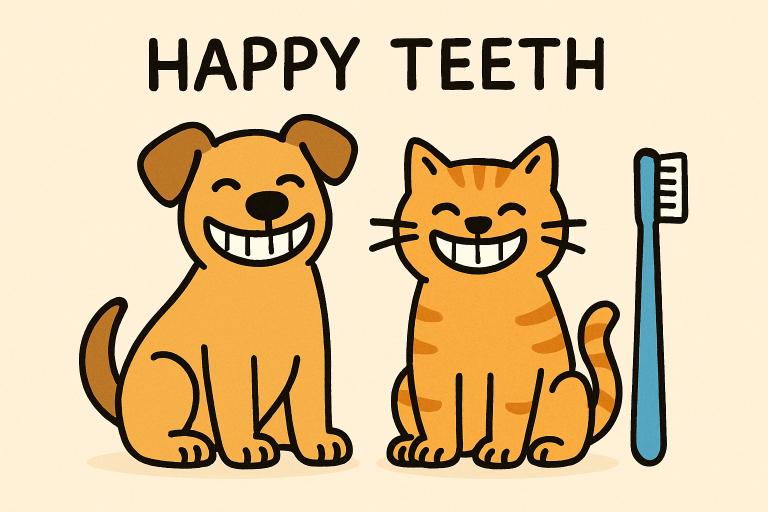Key Takeaways
- Early signs of dental disease in pets can prevent serious complications if caught promptly.
- Watch for symptoms like bad breath, changes in eating habits, or visible oral discomfort.
- Regular dental care, including professional check-ups, is essential for long-term pet health.
Why Dental Health Matters for Pets
Dental health is a critical yet often overlooked aspect of your pet’s overall wellness. Just as in humans, poor oral hygiene in dogs and cats can lead to a variety of health concerns, ranging from pain and infection to heart and kidney disease. Whether your companion is young or entering their golden years, routine attention to dental care keeps them happier and healthier over the long run. For pet owners seeking a trustworthy partner in pet care, Revel Vet offers resources and veterinary expertise dedicated to comprehensive well-being.
Neglecting dental hygiene in pets can lead to serious health risks, as infections may spread through the bloodstream and harm vital organs. A consistent dental care routine not only prevents discomfort and bad breath but also supports a longer, healthier life. Since pets often mask pain, owners should watch for subtle signs of dental disease and seek regular check-ups, especially for breeds prone to oral issues. Experts note that dental disease is one of the most common health concerns in pets, making early detection and care essential for overall well-being.

8 Signs Your Pet Needs a Dental Check-Up
1. Persistent Bad Breath
Occasional bad breath is normal, but a lingering foul odor can signal bacterial buildup and infection. Chronic halitosis is often the first warning sign of dental disease. This odor comes from bacteria breaking down food particles between your pet’s teeth and gums.
2. Discolored or Tartar-Covered Teeth
Pearly white teeth are a reassuring sign of health, but yellowing or brown tartar buildup is a major red flag. Over time, plaque hardens into tartar, which can’t be removed by brushing alone and fosters bacterial growth. Tartar is a breeding ground for infection, leading to further dental decay. According to the American Veterinary Medical Association, regular dental checkups and cleanings are essential to prevent these issues and maintain your pet’s overall health.
3. Red, Swollen, or Bleeding Gums
Healthy gums should be firm and pink. Redness, swelling, or bleeding when chewing indicates inflammation, often a symptom of gingivitis or even periodontal disease. These conditions cause discomfort and pain, and, if left untreated, may result in tooth loss.
4. Difficulty Eating or Loss of Appetite
If your pet suddenly refuses dry food, chews only on one side, or begins to drop food, dental pain may be the culprit. Dental discomfort often causes pets to withdraw from eating hard food or to lose interest in meals altogether.
5. Excessive Drooling or Pawing at the Mouth
Drooling more than usual or repeatedly pawing at the face can signal oral pain. Pets in distress from dental disease may also try rubbing their face on furniture or the floor in an attempt to find relief.
6. Loose or Missing Teeth
Finding a loose tooth or noticing one has gone missing usually means advanced dental disease. The ligaments anchoring the tooth may have deteriorated due to infection, and this stage often requires veterinary intervention.
7. Visible Growths or Lumps in the Mouth
Any unusual mass, swelling, or lump inside your pet’s mouth should be promptly evaluated by a veterinarian, as these could indicate benign growths or, more seriously, tumors or infections.
8. Behavioral Changes
Dental pain can transform your pet’s behavior. You may notice increased irritability, withdrawal, or a reluctance to play or be handled. These changes often stem from discomfort when eating or interacting.
Preventive Measures for Pet Dental Health
- Regular Brushing: Brushing your pet's teeth daily or weekly with a pet-safe toothbrush and toothpaste helps prevent plaque buildup. According to NBC News, even small steps like regular brushing can make a significant difference in maintaining your pet’s oral health.
- Dental Chews and Treats: Quality dental chews approved by the Veterinary Oral Health Council (VOHC) help reduce tartar and clean teeth.
- Routine Veterinary Exams: Annual dental check-ups are essential for catching potential problems before they become serious.
- Professional Cleaning: Your veterinarian can perform deep cleanings and dental X-rays, removing tartar and identifying hidden issues.
Conclusion: Prioritizing Your Pet’s Dental Health
Dental care is more than just a cosmetic concern. It is a vital part of your pet’s overall health and longevity. By staying alert to early warning signs, maintaining preventive routines, and scheduling regular veterinary checkups, you can protect your furry companion from unnecessary pain and serious health complications. Prioritizing dental hygiene ensures not only fresh breath and strong teeth but also a happier, healthier life for your pet.



No comments:
Post a Comment
I love reading and responding to comments but in order to get my reply you must ensure you are NOT a no-reply blogger. If you are, here are some quick steps to change that!
1. Go to the home page of your Blogger account.
2. Select the drop down beside your name on the top right corner and choose Blogger Profile.
3. Select Edit Profile at the top right.
4. Select the Show My Email Address box.
5. Hit Save Profile.